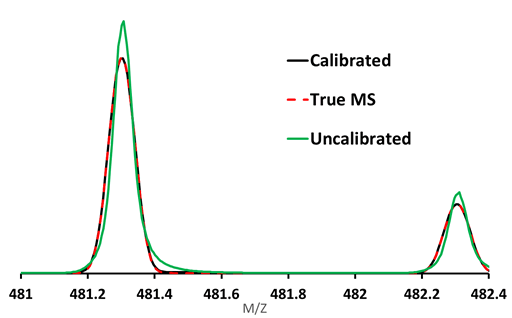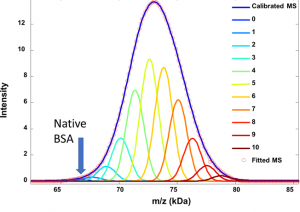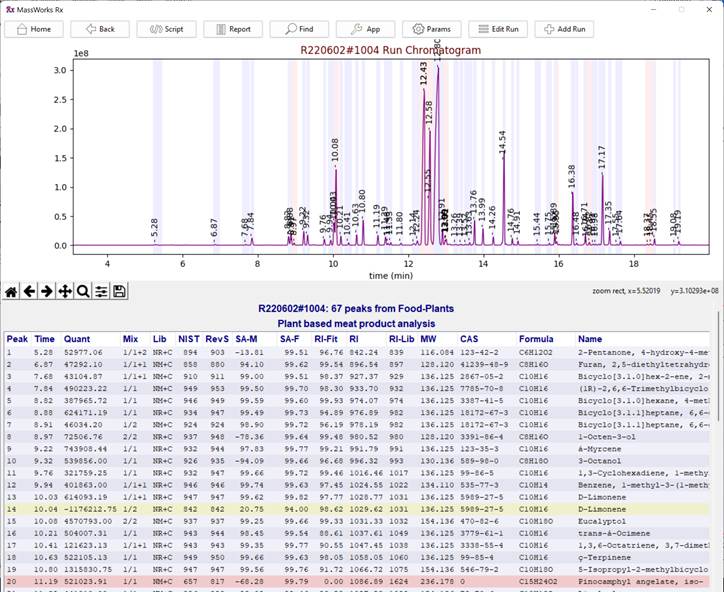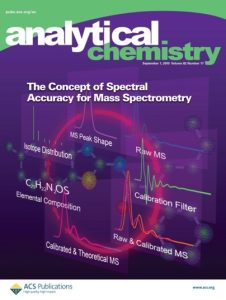Our Technology
Cerno is dedicated to the practical application of modern mathematical techniques to Mass Spectrometry for the purpose of improving the quality, accuracy and reliability of MS analysis. Our technology is vendor neutral and protected through numerous patents granted and submitted world-wide. Founded and staffed by a team with over 90 years’ experience in the fields of instrumentation, mathematical data processing, life science applications and biotech business development.
DEMO YOUR DATA
Learn more about Cerno's patented technology.
For the first time, we can now accurately correct the MS signal to enable new solutions for more confident analysis of both small and large molecules. The analysis of complex mixtures such as labeled isotopes, large molecule adducts, and various modifications are easily and confidently unraveled and quantified. The technology applies to all MS instrumentation, from routine benchtops to state-of-the-art high-resolution instruments.
Our technology can significantly increase the amount of information obtained and reduce the time required for MS experiments. While achieving 99.9% spectral accuracy and saving time in your lab.
- 100x better mass accuracy
- up to 99.9% Spectral Accuracy
- Confident elemental composition determination
- Mixture deconvolution for isotope analysis and large molecule deconvolution
- Self-calibrates peak shape without standards for exact isotope modeling
- Eliminates 95-99% of incorrect formulas with high spectral accuracy
- Quantitative measurements for biologics degradation analysis
Our technology roadmap is influenced by our users and developed by analytical scientists.
For over 20 years, our passion has been in developing advanced mass spectrometry software technology to dramatically improve the accuracy of MS data.
Our patented technologies:
- enable our customers to accelerate their workflows
- and reduce costs while providing more confident answers.
Cerno Introduces SAMMI
Spectrally Accurate Modeling of Multiply charged Ions (SAMMI) calibration technology provides a new innovative approach to large molecule analysis for peptides, proteins, oligonucleotides, and any multiply charged molecule.
SAMMI uses a direct analytical model based on first principles. It will analyze each and every ion of a multiply charged molecule to provide not only the neutral mass, but also the abundance distribution across all the charge states.
Best of all, SAMMI free with the purchase or upgrade of Cerno’s award winning MassWorks software.
FEATUREDTrueCal™
TrueCal provides unsurpassed Spectral Accuracy. Your mass spec data will be as perfect or ideal as what is ultimately possible in the physical sense.
LEARN MOREWhat is Spectral Accuracy
Spectral Accuracy is a measure of the similarity between the measured isotope pattern (ion’s mass spectrum) and the ion’s true mass spectrum sampled in the profile or continuum mode. Proper lineshape calibration enables accurate, complex mixture analysis including quantitation of labeled compounds.
LEARN MOREAuto RI™
Auto RI™ Automatic Retention Index calibration: Our patented technology is used for automatic Retention Index calibration without the need to run any standards, saving you time and enabling enhanced analysis of previously collected data.
LEARN MOREThe concept of Spectral Accuracy for Mass Spectrometry
With the introduction of spectral accuracy, a companion concept to the better known mass accuracy, new capabilities previously thought unfeasible can now be enabled for MS.
VIEW PDFMagicHighlighter™
Color Coded Confidence Indicators. One of the most powerful features of GC/ID 3.0 is the color coding of results to show at a glance, which compounds are likely correct identifications, and which are marginal or poor. This is shown by color coding blue, for high confidence, yellow for medium and red for low. The “Magic” is based on an elegant algorithm that evaluates the NIST Forward and Reverse Search values, the Retention Index (RI) match values (RIFit), and the Spectral Accuracy values (formula identification confidence values) from both the molecular ion, if available, and/or the expected fragment ions. If you do not have accurate mass data, the spectral accuracy values (for example centroid data) are ignored and the match confidence is based on the two Search metrics and the Retention Index match.
LEARN MORECerno Profile Search
Traditional library search, like NIST and PBM (used by Agilent) typically use a pre-filtering algorithm based on pre-selecting a small number of the largest peaks in the spectrum. This dramatically speeds up the search by reducing the total number of library spectra that are fully “matched”. Unfortunately, many time these algorithms don’t work well with mixtures or low signal-to-noise spectra and can filter out exactly the spectrum we are looking for. In some search software, this option can be disabled, but at the cost of speed. Full spectrum search can take over 30 seconds per search, and with hundreds of compounds in the run, well you can see the problem.
LEARN MORECLIPS™
CLIPS Calibrated Line-shape Isotope Profile Search is an entirely new and revolutionary way to attain fast and reliable elemental composition determination.
LEARN MORESearch Mixture Deconvolution
SMD Search Mixture Deconvolution directly fits the mixture spectra with all possible library spectra using multiple linear regression to find which “pure” spectra provide the “best” fit to the mixture spectrum.
LEARN MORETrueChrom MX™
While TrueFit MX provides spectral deconvolution of mixtures considering proposed compounds, TrueChrom MX automatically detects the presence of chromatographically unresolved peaks and determines the number of components in the unresolved peak. TrueFit MX then uses its patent pending deconvolution algorithm to calculate the pure component spectra of each of the components. The pure component spectra can then be analyzed by library search to determine the identity each compound from the unresolved chromatographic peak.
LEARN MORETrueFit MX™
TrueFit MX allows the spectral deconvolution of chromatographically unresolved compounds commonly encountered in labeled isotope work, protein or oligonucleotide modifications, electron impact MS, or even for the direct analysis of complex mixtures. Only Cerno makes such challenging applications routine using the patented TrueCal™ calibration technology and the subsequent application of the CLIPS and sCLIPS multivariate mixture fitting.
LEARN MOREsCLIPS™
sCLIPS (self Calibrating Line-shape Isotope Profile Search) enables users of accurate mass instruments including TOF, high resolution quadrupoles, Orbitrap, magnetic sector, and FT-ICR MS to dramatically improve formula ID through Spectral Accuracy without the need to run calibration standards. The patented sCLIPS approach utilizes the fully resolved monoisotopic peak from high resolution instruments to create a line-shape TrueCal™ calibration that is applied to the entire isotope profile of the ion of interest. This enables exact isotope modeling when comparing the MS response of an unknown ion against the true mass spectra (theoretically calculated responses) for all possible candidate formulas and allows spectral differences as small as 0.1% to be measured, leading to formula ID. One of the benefits of the approach is that it requires no known calibration ions, and instead utilizes the fully resolved monoisotopic peak of the unknown ion itself for the sCLIPS line-shape calibration.
LEARN MOREBest Scan sCLIPS™
Spectral Accuracy analysis of fine isotopes from ultra high resolution MS to help achieve unique Formula ID. In conventional sCLIPS, typically, the averaged MS across a chromatographic peak is used to correct the instrument line-shape and enable exact isotope modeling for Spectral Accuracy evaluation of various possible elemental compositions. With ultra-high resolution MS at ≥ 240,000 resolving power, the observed fine isotopes can vary systematically from scan to scan, depending on the ion population and the associated space charge effects. Best Scan sCLIPS goes beyond the conventional sCLIPS to evaluate the attainable Spectral Accuracy for each and every scan while searching for possible elemental compositions. The scan with the best Spectral Accuracy (oftentimes not at the chromatographic peak apex) will be selected and utilized for accurate elemental composition determination.
LEARN MOREWebinar Series:
Mass Spectral Accuracy: What is it, and Why is it so Important?
WATCHImproving and Automating GC/MS Compound ID on Quadruple MS using Accurate Mass, Spectral Accuracy, Retention Index, and Conventional Search
WATCHDifferentiating the Loss of 43Da EI Fragments (C3H7 or CH3C=O) with Single Quad GC/MS
WATCH
The software that started it all… MassWorks™
Easy-to-use post acquisition software | Achieve high Mass Accuracy and high Spectral Accuracy
With over a dozen patents and 1000’s of users, the award winning MassWorks established the performance benchmark for “True” mass spec calibration. MassWorks is a Windows based desktop software that works with most MS vendor instruments by directly reading the data files making the powerful calibration and analysis technologies available to both nominal and high resolution instruments.
LEARN MOREMassWorks TrueCal™ calibration technology
MassWorks TrueCal™ calibration technology provides advantages for both high and low resolution instruments.

Figure shows an almost perfect match (Spectral Accuracy) between a calibrated single quad and the corresponding “True” calculated MS using the CLIPS search.

Figure shows excellent spectral accuracy match for confident formula ID on a high resolution TOF instrument using sCLIPS search.
Proper mass spec calibration
Proper mass spec calibration also means that complex mixture deconvolution of overlapping and interfering ions is easy and provides the most accurate quantitative results.

Figure shows the accurate quantitative analysis of 7 component mixture of a C13 radio labeled pharmaceutical using a quadrupole instrument.

Figure shows the ability to detect and deconvolve modified products (glycan conjugates 0 – 10) of a large molecule intact protein (by Maldi) (see ASMS poster). This type of analysis is not possible by other means!
Powerful GC/MS Analysis Software – GC/ID™
GC/ID is the first major breakthrough in GC/MS in decades
GC/ID is a fully automated compound identification application that offers new levels of accuracy and confidence in GC/MS qualitative and semi-quantitative analysis. Based on the new MassWorks Rx configurable platform, GC/ID offers powerful new capabilities to GC/MS including:
- Uses the industry standard NIST search engine
- Retention Index (RI) matching provides unsurpassed unknown ID confidence
- Accurate mass analysis of molecular/fragment ions for confident compound ID
- Magic Highlighter indicates at a glance the correct match by combining search, RI, and formula ID


 NSF International
NSF International




